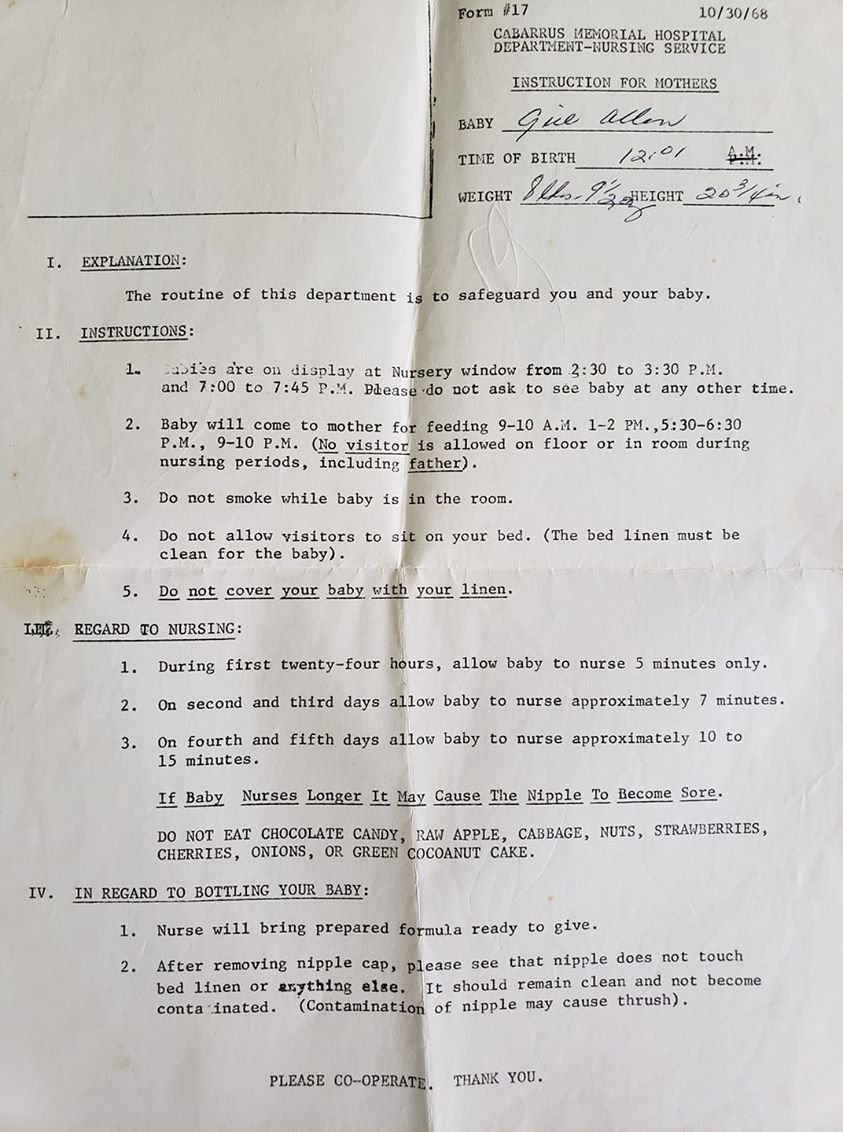This hospital’s postpartum care guidelines from 50 years ago will make you cringe!

Micala Gabrielle Henson posted an image on Facebook of the instructions her mother was given at the hospital after birth in 1968.
You might have seen a picture (above) of “Instructions for Mothers” from 1968 shared on your Facebook newsfeed about a month ago. A woman named Micala Gabrielle Henson shared the handout kept by her mother from when she gave birth, and it’s definitely shown how far we’ve come. There is so much to say about these, but I pulled some of my favorites to dissect the differences between then and now!
Instructions:
1. People could only see their babies from a distance for 1 hour and 45 minutes each day. The staff specifically told them not to even bother asking to have more face time with their little ones! Today, nurseries are definitely still utilized, but families also take advantage of the option to room-in with their babies. In fact, lactation consultants recommend these days to room in with babies to encourage on demand feeding and to help establish a solid breastfeeding relationship.
2. They were given strict time periods they were allowed to feed their babies, and those feeds were scheduled four to four and a half hours apart from each other! These babies clearly weren’t being fed on demand, and fathers weren’t allowed in the room during feedings. Partners actually play a significant role in breastfeeding getting off to the right start including giving emotional support, making sure she has water or snacks within arm’s reach, and assisting with some positioning so it’s not all on mom! For mothers who want to breastfeed, it is so important to feed babies on demand. That frequency will help to bring their milk in. Also, the guidelines we use today are to make sure baby is eating AT LEAST every 2-3 hours during the day and every 3-4 hours at night.
3. Not allowing visitors to sit on the linen isn’t the worst idea, honestly. If you’re concerned about outside germs, you could put an extra sheet on top of the bed for guests and then wash it once they leave. Or you could limit visitors all together! It is okay to be selfish about that precious postpartum time.
4. Safe sleep guidelines today still recommend not putting any sort of blanket on your baby. Babies are often swaddled to keep them warm and snug. Often this is done for you by the nurses, but before you leave the hospital ask to swaddle the baby yourself with the supervision of a nurse. That way you will feel confident about doing it once you are home without a full nursing staff. Getting a swaddler with velcro is also a great parenting hack!
Regard to Nursing:
1. Only allowing baby to nurse for 5 minutes during the first 24 hours seems absurd! Perhaps they meant only 5 minutes at a time...still not recommended at all. Newborns should be able to nurse without time limits. Some will feed for about 30-40 minutes. Some will seem to continuously be at your breast for 1 hour or more. Working with a lactation consultant or breastfeeding counselor can help you distinguish whether the baby is actively feeding or perhaps just soothing. Both are important in establishing a breastfeeding relationship, but at some point you will probably want to take a break and rest!
2. This states that the length of time a baby nurses is what leads to nipples becoming sore, which we know is not the full story. Sore nipples are pretty par for the course when it comes to breastfeeding, but cracked and bleeding nipples are more concerning and that is usually the sign of a shallow or poor latch.
3. Feel free to eat without restrictions in the early days. Have coffee, fish, and whatever you’ve been craving for the past nine months. I’m mostly curious how green coconut cake has fallen in popularity so greatly that it was once listed as a food not to eat alongside apples and chocolate, and I haven’t ever heard of this fascinating dessert!
